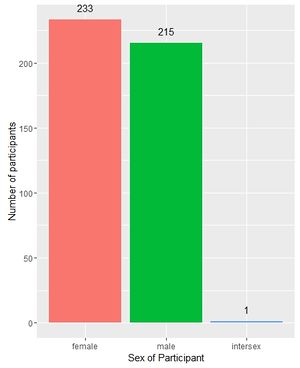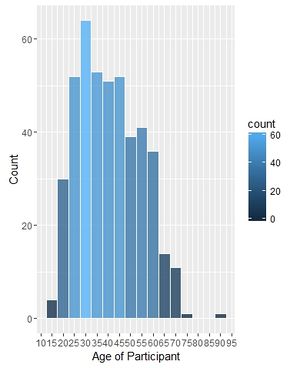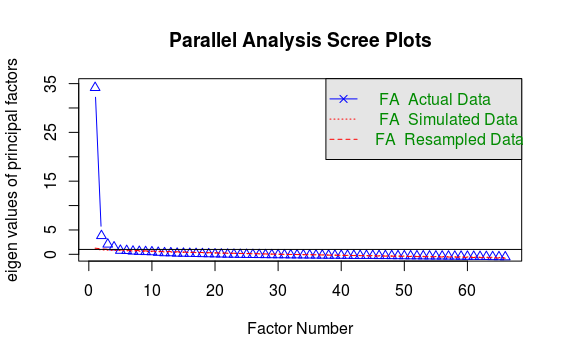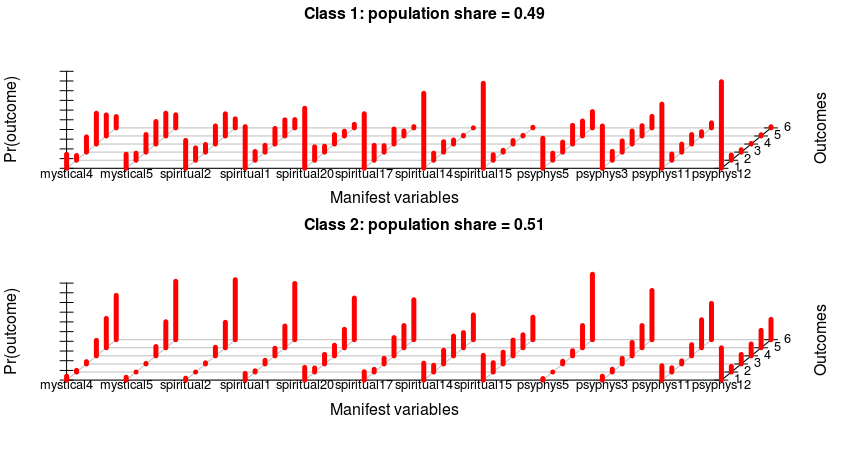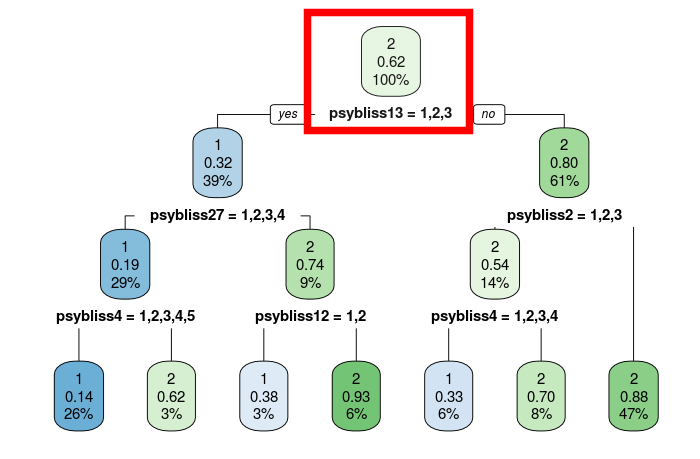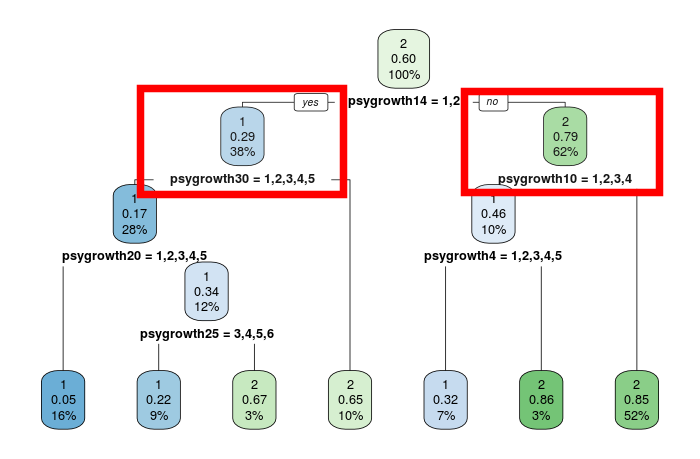Difference between revisions of "Kundalini Profile Survey Analysis"
(→Age and Sex) |
|||
| (44 intermediate revisions by 2 users not shown) | |||
| Line 1: | Line 1: | ||
| − | The Kundalini Profile Survey is part of the Emerging Sciences Foundation's [[Kundalini_Experimental_Project_Overview|Kundalini Experimental Project]] hosted on the [https://www.brilliano.com Brilliano] collaboration tool. The survey contains 268 | + | The Kundalini Profile Survey is part of the Emerging Sciences Foundation's [[Kundalini_Experimental_Project_Overview|Kundalini Experimental Project]] hosted on the [https://www.brilliano.com Brilliano] collaboration tool. The survey contains 268 five-point likert scale questions, open text fields, and questions about the impact of a person's spiritual experiences. The analysis documented on this page is being conducted by the Emerging Sciences Foundation's Kundalini Data Insights team. The complete source code for all analysis presented here can be found on the [https://github.com/emergingsciences/discover Kundalini Discover] project in GitHub. |
| − | + | ||
| − | + | ||
To participate in the Kundalini Experimental Project and contribute important research data, please visit the [https://www.emergingsciences.org/kundalini-experimental-project/ Kundalini Experimental Project page] on the ESF website. | To participate in the Kundalini Experimental Project and contribute important research data, please visit the [https://www.emergingsciences.org/kundalini-experimental-project/ Kundalini Experimental Project page] on the ESF website. | ||
| Line 18: | Line 16: | ||
== Summary Information == | == Summary Information == | ||
| − | To date, ''' | + | To date, '''449''' people from all walks of life and from across the globe have participated in the Kundalini Profile Survey. |
=== Age and Sex === | === Age and Sex === | ||
| Line 30: | Line 28: | ||
|} | |} | ||
| − | === Core | + | === Core Experience Summary === |
The survey contains a list of 66 "core experience" questions describing classical Kundalini awakening indicators. The list was derived from previous surveys and existing literature, and respondents reported the strength of their experiences along a 5-point likert scale. | The survey contains a list of 66 "core experience" questions describing classical Kundalini awakening indicators. The list was derived from previous surveys and existing literature, and respondents reported the strength of their experiences along a 5-point likert scale. | ||
| Line 36: | Line 34: | ||
The survey contains three categories of experiences: | The survey contains three categories of experiences: | ||
| − | Mystical indicators are those that typically transcend the normal bounds of human experience. Spiritual indicators are those that, although they may have sublime characteristics, might not be as radical as mystical experiences. Psychophysiological indicators are those that affect the body and mind through some not yet understood connecting medium | + | # Mystical indicators are those that typically transcend the normal bounds of human experience. |
| + | # Spiritual indicators are those that, although they may have sublime characteristics, might not be as radical as mystical experiences. | ||
| + | # Psychophysiological indicators are those that affect the body and mind through some not yet understood connecting medium. | ||
| − | In general, the data shows a very common occurrence of powerful, transformative experiences among respondents. | + | In the data, these are represented as the <code>mystical</code>, <code>spiritual</code>, and <code>psyphys</code> (psychophysiolocical) question categories. In general, the data shows a very common occurrence of powerful, transformative experiences among respondents. Prevalent experiences in each category include: |
| + | |||
| + | * Mystical experiencies associated with the perception of unity and consciousness. | ||
| + | * Spiritual indicators associated with wisdom and intuition. | ||
| + | * Psychophysiolocal experiences associated with energy vibrating or moving in the body. | ||
| Line 48: | Line 52: | ||
|} | |} | ||
| − | == Factor Analysis and | + | == Primary Experience Categories Factor Analysis == |
| − | === Factor | + | |
| − | === Variable | + | Factor analysis was conducted on the 66 primary experience questions. Factor analysis is a technique of identifying groups of correlated variables that correspond to latent categories of experiences. The mystical, spiritual, and psychophysiological question categories were analyzed. The number of factors to be determined per category was determined using an empirical technique known as parallel analysis. Principal Axis Factoring with Promax rotation was performed, a technique commonly used for this type of psychological data. |
| − | === | + | |
| + | One key observation during this process was the prominence of a single factor, labeled "Higher Consciousness," which accounted for a very large portion of explained variance in the data. To illustrate this point, all 66 questions were used in the following scree plot, in which Higher Consciousness is shown as the first factor: | ||
| + | |||
| + | [[File:Mystical-spiritual-psyphys-parallel-scree.png|center|Scree plot showing an extremely eigenvalue for high Higher Consciousness]] | ||
| + | |||
| + | According to the Kundalini Hypothesis, Higher Consciousness is the goal of the Kundalini biological mechanism, and all other manifestations of Kundalini are secondary effects. In our analysis, Higher Consciousness was characterized by: | ||
| + | |||
| + | # The direct perception of consciousness. | ||
| + | # Unity and the personal identification with all of creation | ||
| + | |||
| + | Factor analysis yielded the resulting factors in each major experience category. The questions listed below have a factor loading > ~0.6. This threshold was selected for interpretability of the data: | ||
| + | |||
| + | |||
| + | === Mystical Question Factors === | ||
| + | |||
| + | {| class="wikitable" | ||
| + | ! Higher Consciousness !! Ecstacy !! Grace Experiences | ||
| + | |- | ||
| + | | Experience of Higher consciousness/cosmic consciousness || Intense feeling of peace || Tasting sacred nectar dripping from the roof of mouth or back of throat (amrita or soma) | ||
| + | |- | ||
| + | | Expansion of consciousness || Overwhelming sense of love || Experiences or visions of deities, gurus, icons, saints or mystics or other religious prophets, religious icons or universal archetypes | ||
| + | |- | ||
| + | | Revelation: Knowledge that comes from a divine source where the individual becomes aware of the source of that knowledge || Overwhelming sense of bliss, joy and or contentment || Receiving instructions from the divine | ||
| + | |- | ||
| + | | New knowledge / awareness of the unbounded intelligence behind universe || Overwhelming sense of wonder and awe || Feeling sacred touch (wind, presence, touch) | ||
| + | |- | ||
| + | | Personal identification with all of creation || || Visions of glowing geometric shapes | ||
| + | |- | ||
| + | | Expanded comprehension of reality || || | ||
| + | |- | ||
| + | | Experience of deep unity and expansive consciousness || || | ||
| + | |- | ||
| + | | Union with Life Energy || || | ||
| + | |- | ||
| + | | All sense of separateness disappears || || | ||
| + | |- | ||
| + | | An experience of union with the Divine-God or universal consciousness || || | ||
| + | |} | ||
| + | |||
| + | |||
| + | === Spiritual Question Factors === | ||
| + | |||
| + | {| class="wikitable" | ||
| + | ! Rebirth !! Intuition !! Synchronicity !! Out of Body !! Aural | ||
| + | |- | ||
| + | | New understanding of spiritual truths/Insight into the inner meaning of spiritual teachings || Feeling of connection with a spiritual guide or lineage || Spontaneously going into a deep meditative experience || Out of body experiences || Sacred auditions (of teachings, mantras, music) | ||
| + | |- | ||
| + | | Spiritual rebirth - spontaneous religious conversion or dramatic spiritual awakening, including a major reorientation of spiritual beliefs. || Receiving inner instruction || Increased experience of unsual synchronistic events || Astral/time travel experiences || Glossalalia (spontaneously reciting phonemes, mantras, prayers, or poems, singing hymns, or speaking foreign languages unknown to the individual) | ||
| + | |- | ||
| + | | An unshakable conviction about the reality of the experience || || Inspired creativity || Encounters with nonmaterial entities(the deceased, lower astral beings, aliens, spirit guides) || | ||
| + | |- | ||
| + | | Transient, atypical, pivotal, or opening experiences || || || || | ||
| + | |} | ||
| + | |||
| + | |||
| + | === Psychophysiological Question Factors === | ||
| + | |||
| + | {| class="wikitable" | ||
| + | ! Energy Sensations !! Light | ||
| + | |- | ||
| + | | Feelings of energy flowing or vibrating within || Visions of light | ||
| + | |- | ||
| + | | Sensations of energy rushing up the spine || Floating in the light | ||
| + | |- | ||
| + | | Sensations of energy along the seven major chakras (chakras are spinning vortices of energy) that run from the base of the spine to the crown of the head || Sensations of white light or luminosity | ||
| + | |- | ||
| + | | Inner sensations of heat or cold || | ||
| + | |- | ||
| + | | Transient or unusual symptoms or some features atypical for a standard diagnosis || | ||
| + | |} | ||
| + | |||
| + | |||
| + | === Backlog === | ||
| + | |||
| + | * Factor correlations and diagrams. | ||
| + | * ICLUST analysis and diagrams. | ||
| + | * Pairwise correlations | ||
| + | |||
| + | == The Mystical Classification (M-Class) Model == | ||
| + | |||
| + | The '''M-Class''' ('''mclass''') or "mystical classification" is a way to classify survey participants into distinct groups. The purpose of the M-Class model is to understand the differences between distinct types of Kundalini experiences and to develop methods to awaken Kundalini and reach Higher Consciousness. | ||
| + | |||
| + | The M-Class model uses Latent Class Analysis (LCA), a special type of mixture model developed for polytomous data. Other forms of cluster analysis such as K-means are based on arbitrary Euclidean distances, whereas latent class analysis is probabilistic and based on maximum likelihood estimates, and is thus a more empirical approach to clustering. | ||
| + | |||
| + | From the factor analysis (see above), key variables were identified and used in the M-Class model to classify respondents into different groups. The variables used are listed below: | ||
| + | |||
| + | === M-Class Model Variables === | ||
| + | |||
| + | {| class="wikitable" | ||
| + | ! Variable Name !! Likert Question Text !! Experience Type (from factor analysis) !! Used as predictor variable? !! Used as an indicator variable? | ||
| + | |- | ||
| + | | mystical4 || Intense feeling of peace || Ecstacy || || Yes | ||
| + | |- | ||
| + | | mystical5 || Overwhelming sense of love || Ecstacy || || Yes | ||
| + | |- | ||
| + | | mystical13 || All sense of separateness disappears || Union || Yes || | ||
| + | |- | ||
| + | | mystical22 || Expansion of consciousness || Consciousness || Yes || | ||
| + | |- | ||
| + | | mystical24 || Experience of Higher consciousness/cosmic consciousness || Consciousness || Yes || | ||
| + | |- | ||
| + | | mystical26 || Personal identification with all of creation || Union || Yes || | ||
| + | |- | ||
| + | | spiritual1 || Spiritual rebirth - spontaneous religious conversion or dramatic spiritual awakening, including a major reorientation of spiritual beliefs. || Rebirth || || Yes | ||
| + | |- | ||
| + | | spiritual2 || New understanding of spiritual truths/Insight into the inner meaning of spiritual teachings || Rebirth || || Yes | ||
| + | |- | ||
| + | | spiritual14 || Out of body experiences || OOB || || Yes | ||
| + | |- | ||
| + | | spiritual15 || Astral/time travel experiences || OOB || || Yes | ||
| + | |- | ||
| + | | spiritual17 || Receiving inner instruction || Intuition || || Yes | ||
| + | |- | ||
| + | | spiritual20 || Feeling of connection with a spiritual guide or lineage || Intuition || || Yes | ||
| + | |- | ||
| + | | psyphys3 || Sensations of energy rushing up the spine || Energy || || Yes | ||
| + | |- | ||
| + | | psyphys5 || Feelings of energy flowing or vibrating within || Energy || || Yes | ||
| + | |- | ||
| + | | psyphys11 || Visions of light || Light || || Yes | ||
| + | |- | ||
| + | | psyphys12 || Floating in the light || Light || || Yes | ||
| + | |} | ||
| + | |||
| + | |||
| + | Based on this model specification, two classes of experiencers were identified using the lowest Bayesian information criterion (BIC) out of a trial of 2-10 classes. The two distinct groups of experiencers are: | ||
| + | |||
| + | * '''Class 1 ("Kundalini stirring or Kundalini inactive")''' - These individuals were either symptomatic, or had very few symptoms of a Kundalini awakening. The group comprised 49% of respondents. | ||
| + | * '''Class 2 ("Kundalini active")''' - Kundalini active respondents. These individuals generally had strong indications of Higher Consciousness (probably at least one peak experience). Out of Body and Light sensations occurred less frequently, but still more often than in the Class 1 group. The group comprised a 51% of respondents, which is representative only of the people filling out the survey, rather than the general population. The percentage of people with these types of experiences within the general population is unknown and would be a desirable data point. | ||
| + | |||
| + | |||
| + | [[File:Mclass-model-3d.png|center|frame|Profile chart of class probabilities by indicator variable for a 2-level M-Class model. 1 = 'Not at all', 2 = 'Very Weak/low intensity', 3 = 'Weak', 4= 'Moderate', 5 = 'Strong', 6 = 'Very strong/high intensity']] | ||
| + | |||
| + | The M-Class is not a static model, but one that will be refined based on multiple criteria, including confirmatory analysis, interpretability, and experimental value. | ||
| + | |||
| + | == M-Class Profiles == | ||
| + | |||
| + | This research assumes that people falling under different M-Class's will have different characteristics, behaviors, etc. Profiling means to examine each M-Class group and determine what these attributes are. Profiling of the M-Class model was first conducted using decision trees. Decision trees are a machine learning algorithm which looks at an outcome variable, in this case the mclass variable, and determines the best way to predict that outcome (or set of outcomes) based on the values of a number of predictor variables. The output is provided in the form of a tree plot. More information about how to interpret the tree plots used in our analysis can be found [http://www.milbo.org/rpart-plot/prp.pdf here (external PDF)]. | ||
| + | |||
| + | ==== Psychological Differences ==== | ||
| + | |||
| + | A decision tree analysis was run on psychological indicators (<code>psygrowth</code> and <code>psybliss</code>). The question answered is "what are the major psychological differences between Class 1 and Class 2 groups (limited by the types of questions asked)?" Analysis of the decision tree revealed three variables that appear related to the psychological profile of both groups of participants. Class 2 was more likely to indicate the following as psychological attributes: | ||
| + | |||
| + | * '''Devotional focus''' (<code>psybliss13</code>) | ||
| + | * '''An interest in helping others, compassion for the suffering''' (<code>psygrowth10</code>) | ||
| + | * '''Deep compassion''' (<code>psygrowth30</code>) | ||
| + | |||
| + | The pattern of experience is clear - a more devotional, compassionate frame of mind appears to play an important role in the Kundalini process. The decision trees used in this analysis are included below, with the variables above highlighted in red. | ||
| + | |||
| + | [[File:Psybliss-mclass-decisiontree.png]] | ||
| + | [[File:Psygrowth-mclass-decisiontree.png]] | ||
| − | == | + | == Backlog: Open text cross-validation == |
| − | + | * Ensure consistency by analyzing open text responses. | |
Latest revision as of 01:12, 2 April 2017
The Kundalini Profile Survey is part of the Emerging Sciences Foundation's Kundalini Experimental Project hosted on the Brilliano collaboration tool. The survey contains 268 five-point likert scale questions, open text fields, and questions about the impact of a person's spiritual experiences. The analysis documented on this page is being conducted by the Emerging Sciences Foundation's Kundalini Data Insights team. The complete source code for all analysis presented here can be found on the Kundalini Discover project in GitHub.
To participate in the Kundalini Experimental Project and contribute important research data, please visit the Kundalini Experimental Project page on the ESF website.
Contents
Analysis Goals
The Kundalini Profile Survey was created to document the types of spiritual experiences people are having, and associated physical and psychological experiences.
Analysis on the Kundalini Profile Survey has a few basic goals:
- Discover groupings of Kundalini experiences that occur together.
- Explore the relationship between different experience types and other physical and psychological experiences.
- Create an empirical, data-driven way of classifying a person's spiritual experiences.
- Lay the groundwork for future experimentation on Kundalini by providing important measures that can be used to track progress. Future research will focus on potential ways to enhance or accelerate the Kundalini process. Kundalini is seen as the biological basis of all spiritual experiences.
Summary Information
To date, 449 people from all walks of life and from across the globe have participated in the Kundalini Profile Survey.
Age and Sex
There has been broadly an equal participation from men and women, although there were slightly more women who took part. People of all ages have taken part in the survey with the majority of respondants being around the age of 30.
Core Experience Summary
The survey contains a list of 66 "core experience" questions describing classical Kundalini awakening indicators. The list was derived from previous surveys and existing literature, and respondents reported the strength of their experiences along a 5-point likert scale.
The survey contains three categories of experiences:
- Mystical indicators are those that typically transcend the normal bounds of human experience.
- Spiritual indicators are those that, although they may have sublime characteristics, might not be as radical as mystical experiences.
- Psychophysiological indicators are those that affect the body and mind through some not yet understood connecting medium.
In the data, these are represented as the mystical, spiritual, and psyphys (psychophysiolocical) question categories. In general, the data shows a very common occurrence of powerful, transformative experiences among respondents. Prevalent experiences in each category include:
- Mystical experiencies associated with the perception of unity and consciousness.
- Spiritual indicators associated with wisdom and intuition.
- Psychophysiolocal experiences associated with energy vibrating or moving in the body.
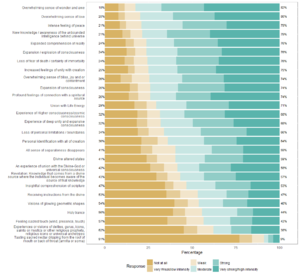 Mystical likert questions summary. Available in PDF: File:Mystical-likert.pdf |
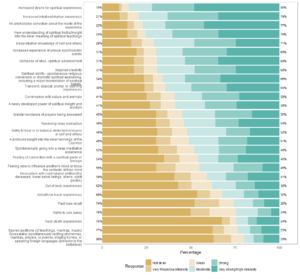 Spiritual likert questions summary. Available in PDF: File:Spiritual-likert.pdf |
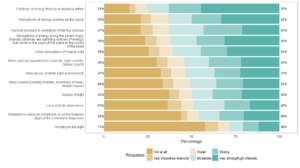 Psychophysiological likert questions summary. Available in PDF: File:Psychophysiological-likert.pdf |
Primary Experience Categories Factor Analysis
Factor analysis was conducted on the 66 primary experience questions. Factor analysis is a technique of identifying groups of correlated variables that correspond to latent categories of experiences. The mystical, spiritual, and psychophysiological question categories were analyzed. The number of factors to be determined per category was determined using an empirical technique known as parallel analysis. Principal Axis Factoring with Promax rotation was performed, a technique commonly used for this type of psychological data.
One key observation during this process was the prominence of a single factor, labeled "Higher Consciousness," which accounted for a very large portion of explained variance in the data. To illustrate this point, all 66 questions were used in the following scree plot, in which Higher Consciousness is shown as the first factor:
According to the Kundalini Hypothesis, Higher Consciousness is the goal of the Kundalini biological mechanism, and all other manifestations of Kundalini are secondary effects. In our analysis, Higher Consciousness was characterized by:
- The direct perception of consciousness.
- Unity and the personal identification with all of creation
Factor analysis yielded the resulting factors in each major experience category. The questions listed below have a factor loading > ~0.6. This threshold was selected for interpretability of the data:
Mystical Question Factors
| Higher Consciousness | Ecstacy | Grace Experiences |
|---|---|---|
| Experience of Higher consciousness/cosmic consciousness | Intense feeling of peace | Tasting sacred nectar dripping from the roof of mouth or back of throat (amrita or soma) |
| Expansion of consciousness | Overwhelming sense of love | Experiences or visions of deities, gurus, icons, saints or mystics or other religious prophets, religious icons or universal archetypes |
| Revelation: Knowledge that comes from a divine source where the individual becomes aware of the source of that knowledge | Overwhelming sense of bliss, joy and or contentment | Receiving instructions from the divine |
| New knowledge / awareness of the unbounded intelligence behind universe | Overwhelming sense of wonder and awe | Feeling sacred touch (wind, presence, touch) |
| Personal identification with all of creation | Visions of glowing geometric shapes | |
| Expanded comprehension of reality | ||
| Experience of deep unity and expansive consciousness | ||
| Union with Life Energy | ||
| All sense of separateness disappears | ||
| An experience of union with the Divine-God or universal consciousness |
Spiritual Question Factors
| Rebirth | Intuition | Synchronicity | Out of Body | Aural |
|---|---|---|---|---|
| New understanding of spiritual truths/Insight into the inner meaning of spiritual teachings | Feeling of connection with a spiritual guide or lineage | Spontaneously going into a deep meditative experience | Out of body experiences | Sacred auditions (of teachings, mantras, music) |
| Spiritual rebirth - spontaneous religious conversion or dramatic spiritual awakening, including a major reorientation of spiritual beliefs. | Receiving inner instruction | Increased experience of unsual synchronistic events | Astral/time travel experiences | Glossalalia (spontaneously reciting phonemes, mantras, prayers, or poems, singing hymns, or speaking foreign languages unknown to the individual) |
| An unshakable conviction about the reality of the experience | Inspired creativity | Encounters with nonmaterial entities(the deceased, lower astral beings, aliens, spirit guides) | ||
| Transient, atypical, pivotal, or opening experiences |
Psychophysiological Question Factors
| Energy Sensations | Light |
|---|---|
| Feelings of energy flowing or vibrating within | Visions of light |
| Sensations of energy rushing up the spine | Floating in the light |
| Sensations of energy along the seven major chakras (chakras are spinning vortices of energy) that run from the base of the spine to the crown of the head | Sensations of white light or luminosity |
| Inner sensations of heat or cold | |
| Transient or unusual symptoms or some features atypical for a standard diagnosis |
Backlog
- Factor correlations and diagrams.
- ICLUST analysis and diagrams.
- Pairwise correlations
The Mystical Classification (M-Class) Model
The M-Class (mclass) or "mystical classification" is a way to classify survey participants into distinct groups. The purpose of the M-Class model is to understand the differences between distinct types of Kundalini experiences and to develop methods to awaken Kundalini and reach Higher Consciousness.
The M-Class model uses Latent Class Analysis (LCA), a special type of mixture model developed for polytomous data. Other forms of cluster analysis such as K-means are based on arbitrary Euclidean distances, whereas latent class analysis is probabilistic and based on maximum likelihood estimates, and is thus a more empirical approach to clustering.
From the factor analysis (see above), key variables were identified and used in the M-Class model to classify respondents into different groups. The variables used are listed below:
M-Class Model Variables
| Variable Name | Likert Question Text | Experience Type (from factor analysis) | Used as predictor variable? | Used as an indicator variable? |
|---|---|---|---|---|
| mystical4 | Intense feeling of peace | Ecstacy | Yes | |
| mystical5 | Overwhelming sense of love | Ecstacy | Yes | |
| mystical13 | All sense of separateness disappears | Union | Yes | |
| mystical22 | Expansion of consciousness | Consciousness | Yes | |
| mystical24 | Experience of Higher consciousness/cosmic consciousness | Consciousness | Yes | |
| mystical26 | Personal identification with all of creation | Union | Yes | |
| spiritual1 | Spiritual rebirth - spontaneous religious conversion or dramatic spiritual awakening, including a major reorientation of spiritual beliefs. | Rebirth | Yes | |
| spiritual2 | New understanding of spiritual truths/Insight into the inner meaning of spiritual teachings | Rebirth | Yes | |
| spiritual14 | Out of body experiences | OOB | Yes | |
| spiritual15 | Astral/time travel experiences | OOB | Yes | |
| spiritual17 | Receiving inner instruction | Intuition | Yes | |
| spiritual20 | Feeling of connection with a spiritual guide or lineage | Intuition | Yes | |
| psyphys3 | Sensations of energy rushing up the spine | Energy | Yes | |
| psyphys5 | Feelings of energy flowing or vibrating within | Energy | Yes | |
| psyphys11 | Visions of light | Light | Yes | |
| psyphys12 | Floating in the light | Light | Yes |
Based on this model specification, two classes of experiencers were identified using the lowest Bayesian information criterion (BIC) out of a trial of 2-10 classes. The two distinct groups of experiencers are:
- Class 1 ("Kundalini stirring or Kundalini inactive") - These individuals were either symptomatic, or had very few symptoms of a Kundalini awakening. The group comprised 49% of respondents.
- Class 2 ("Kundalini active") - Kundalini active respondents. These individuals generally had strong indications of Higher Consciousness (probably at least one peak experience). Out of Body and Light sensations occurred less frequently, but still more often than in the Class 1 group. The group comprised a 51% of respondents, which is representative only of the people filling out the survey, rather than the general population. The percentage of people with these types of experiences within the general population is unknown and would be a desirable data point.
The M-Class is not a static model, but one that will be refined based on multiple criteria, including confirmatory analysis, interpretability, and experimental value.
M-Class Profiles
This research assumes that people falling under different M-Class's will have different characteristics, behaviors, etc. Profiling means to examine each M-Class group and determine what these attributes are. Profiling of the M-Class model was first conducted using decision trees. Decision trees are a machine learning algorithm which looks at an outcome variable, in this case the mclass variable, and determines the best way to predict that outcome (or set of outcomes) based on the values of a number of predictor variables. The output is provided in the form of a tree plot. More information about how to interpret the tree plots used in our analysis can be found here (external PDF).
Psychological Differences
A decision tree analysis was run on psychological indicators (psygrowth and psybliss). The question answered is "what are the major psychological differences between Class 1 and Class 2 groups (limited by the types of questions asked)?" Analysis of the decision tree revealed three variables that appear related to the psychological profile of both groups of participants. Class 2 was more likely to indicate the following as psychological attributes:
- Devotional focus (
psybliss13) - An interest in helping others, compassion for the suffering (
psygrowth10) - Deep compassion (
psygrowth30)
The pattern of experience is clear - a more devotional, compassionate frame of mind appears to play an important role in the Kundalini process. The decision trees used in this analysis are included below, with the variables above highlighted in red.
Backlog: Open text cross-validation
- Ensure consistency by analyzing open text responses.
